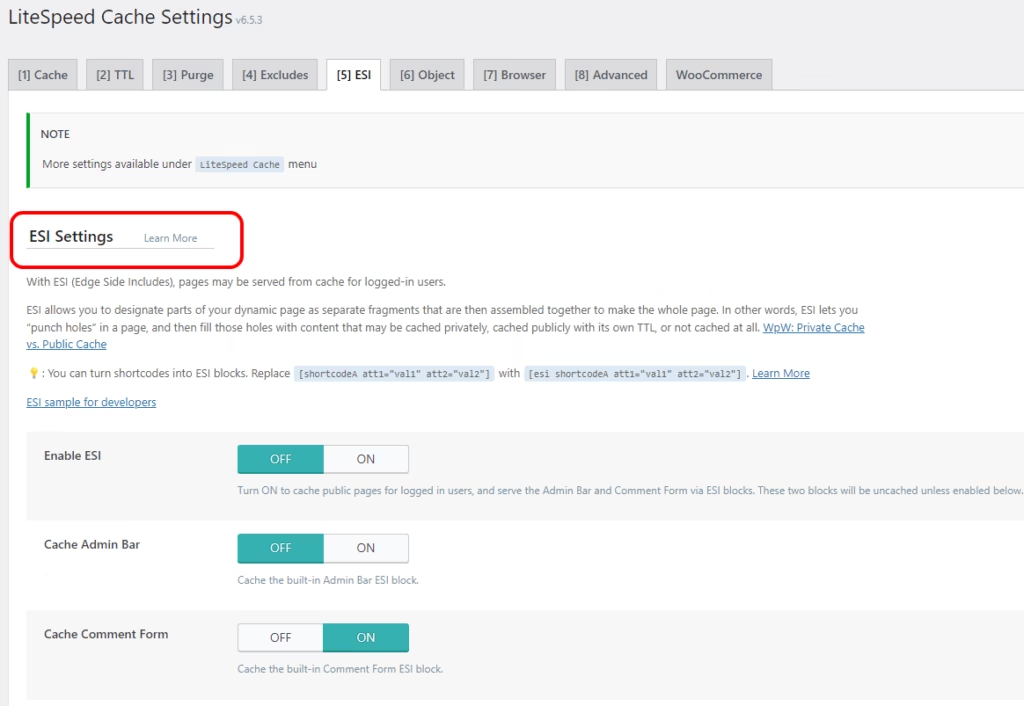Explicación de la configuración de LiteSpeed Cache ESI
Edge Side Includes (ESI) is a powerful feature that helps websites improve their caching strategies, especially for dynamic content. By enabling ESI, you can serve cached pages even for logged-in users while maintaining dynamic functionality.
What is ESI?
ESI allows developers to split a webpage into dynamic and static fragments. While static fragments can be cached and served quickly, dynamic fragments can be updated or personalized without reloading the entire page.
This technique essentially creates “holes” in the static content, which are later filled with dynamic data, enabling efficient content delivery without compromising functionality.
For instance:
- Static Content: Can be cached and reused across all visitors.
- Contenido dinámico: Personalized elements like user-specific data, forms, or admin panels.
ESI ensures that these fragments are served efficiently, enhancing the overall page load speed and reducing server resource usage.
Why ESI is Important Element in Caching
- Improved Performance for Logged-in Users: ESI makes it possible to serve cached pages for logged-in users by separating dynamic and static content.
- Better Cache Utilization: By caching public and private fragments independently, ESI maximizes caching potential.
- Flexibility with Content TTL (Time-to-Live): ESI allows developers to set different TTLs for various page components, ensuring timely updates for dynamic data.
- Reduced Server Load: Static fragments are served directly from cache, minimizing server resource consumption.
Exploring LiteSpeed Cache ESI Settings
LiteSpeed Cache makes it easier to implement ESI with a simple interface. Here’s a breakdown of the ESI settings:

1. Enable ESI:
- Option: Toggle ESI On or Off.
- Function: When enabled, LiteSpeed can cache public pages for logged-in users. This setting is the cornerstone of ESI, ensuring personalized and static content are handled separately.
2. Cache Admin Bar:
- Option: Enable or Disable.
- Function: Caches the WordPress Admin Bar as an ESI block. When enabled, it prevents the Admin Bar from being dynamically loaded each time, improving performance for logged-in administrators.
3. Cache Comment Form:
- Option: Enable or Disable.
- Function: Caches the WordPress comment form as an ESI block. By enabling this, you reduce server load while ensuring the form remains functional for user interactions.

4. ESI Nonces
What are ESI Nonces? Nonces are unique tokens used in WordPress to secure URLs and forms. They ensure that actions or forms on your website cannot be abused by unauthorized users. LiteSpeed Cache enables you to manage these nonces using ESI, converting them into ESI blocks automatically.
Configuration in LiteSpeed:
- Field: Add nonce names (e.g.,
stats_nonce,subscribe_nonce) one per line. - Optional Parameters: Specify caching rules with additional parameters:
- Por ejemplo:
my_nonce_action private
- Por ejemplo:
- Wildcard Support: Use wildcards (
*) to match multiple nonces, such asnonce_formid_*.
How It Works: By declaring these nonces in the ESI settings, LiteSpeed handles them as separate fragments, ensuring secure and dynamic interaction with cached pages.
5. Vary Group
What is Vary Group? The Vary Group setting allows you to control cache variations based on user roles. This is useful for scenarios where certain roles, like administrators, need to see tailored content (e.g., an edit link on pages) while other users see the default cached content.
Settings Breakdown:
- Each user role (e.g., Administrator, Author, Customer) can be assigned a group ID.
- Assign 99 to a role (such as Administrator) to create a separate cache version for that group.
- Other roles with a group ID of 0 will share the default public cache.
Practical Use Cases:
- Administrators: Allow separate caching for administrators to include dynamic elements like dashboard links or admin-specific options.
- Subscribers/Customers: Retain default caching for regular users or customers who access static content.
Benefits:
- Prevents cache contamination between user roles.
- Ensures accurate display of role-specific dynamic content.
How These Features Enhance Performance
- ESI Nonces: Securely integrate dynamic user actions within cached pages without compromising page speed.
- Vary Group: Optimizes cache utilization by delivering the right content to the right audience, improving both user experience and backend efficiency.
How to Use ESI in LiteSpeed Cache?
Using ESI requires designating parts of a page as ESI blocks. For instance, replace your shortcode [shortcodeA attr1="val1" attr2="val2"] with [esi shortcodeA attr1="val1" attr2="val2"]. This tells LiteSpeed to treat this fragment dynamically.
For developers, LiteSpeed also offers sample codes and tutorials to help implement ESI efficiently.
Results of Using ESI
- Faster Page Loads: Static content loads instantly, while dynamic content is fetched only when needed.
- Improved User Experience: By maintaining fast speeds for logged-in users, ESI ensures smooth interactions with your website.
- Cost Savings: Reduced server resource usage translates to lower hosting costs.
ESI is a game-changer for websites that cater to both logged-in and guest users. With LiteSpeed Cache’s intuitive ESI settings, you can boost your website’s speed, enhance user experience, and optimize resource usage effectively. Implement ESI today to see the difference in your website’s performance!

